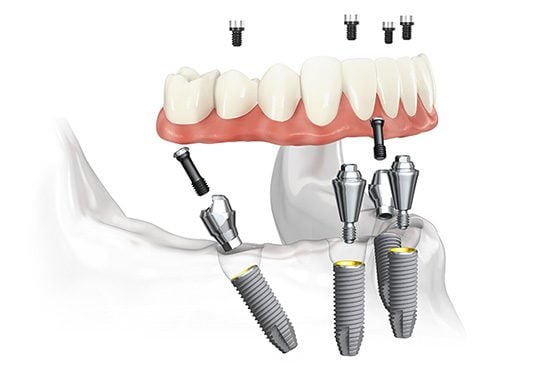
Complete Guide To All-On-4 Dental Implants
If you happen to be missing a significant number of your teeth, the all-on-four implant procedure might be the better replacement tooth option for you.
This is because the all-on-four implant procedure is able to replace an entire set of teeth more efficiently than traditional dental implants.
This procedure is even effective for people who have extensive bone loss.
The basis of the all-on-four method is a process known as osseointegration where the implant and your jawbone are bound together so as to make the implant a permanent fixture in the mouth.
What Are All-On-Four Dental Implants?
All-On-4 dental implants are a type of dental implant that is gaining in popularity. This is because they offer many benefits over traditional dental implants. In this guide, we’ll take a look at what All-On-4 dental implants are, how they work, the benefits and risks of All-On-4 implants, and the history of the All-On-4 technique.
An all-on-four dental implant is a type of dental implant that uses four implants to support a full arch of teeth. The implants are placed into the jawbone and function as anchors for the new teeth. All-On-4 implants are usually made from titanium, which is a biocompatible metal that is well tolerated by the body.
The teeth are attached to the implants using screws or abutments. All-on-four dental implants are strong and durable, and they can last for many years with proper care.
How All-On-Four Work
The All-On-4 dental implant technique was developed in the late 1990s by Dr. Paulo Malo. All-On-4 dental implants are a type of dental implant that uses four implants to support a full arch of teeth. All-On-4 dental implants are different from traditional dental implants in that they don’t require a sinus lift or bone graft. This makes the All-On-4 technique less invasive and less expensive than traditional dental implant surgery.
All-on-four dental implants are placed in the jawbone using a minimally invasive surgical technique. First, the implant site is prepared by making small incisions in the gum tissue. Next, the implants are placed in the jawbone. Once the implants are in place, the gum tissue is closed with sutures. The All-On-4 implant surgery is typically done under local anesthesia and does not require a hospital stay.
Traditional Implants Vs All-On-Four
Traditional dental implants have been used for many years and are an effective method for replacing missing teeth. Though, there are some drawbacks to traditional implants. One of the biggest drawbacks is that traditional implants require a large amount of healthy bone in order to be placed. This can be a problem for people who have lost a lot of bone due to periodontal disease or who have had previous dental work that has damaged the bone.
All-On-4 dental implants are a newer type of implant that was developed to overcome the problems associated with traditional implants. All-On-4 implants are placed in the jaw using just four screws. This means that All-On-4 implants can be placed in areas where there is less bone, making them a good option for people who have lost bone due to periodontal disease or previous dental work.
Traditional dental implants are made of titanium and are placed in the jawbone. The titanium screw fuses with the jawbone and acts as a artificial tooth root. Once the implant has fused with the jawbone, a artificial tooth (crown) is placed on top of the implant.
All-on-four implants are placed in the jaw using just four screws. This means that All-On-4 implants can be placed in areas where there is less bone, making them a good option for people who have lost bone due to periodontal disease or previous dental work.
Ideal Candidate
- People whose jawbones are not dense enough to support a large number of traditional implants.
- Individuals who wear dentures and are tired of the removable appliances
- Anyone requiring an entirely new set of teeth or full arch replacement
- Additionally, all-on-four implants can also be a good alternative for people who do not wish to go through lengthy implant procedures where soft tissue regeneration, bone augmentation, or multiple implants are needed.
- Specifically, this procedure targets people with poor bone density, thus making bone augmentation unideal.
5 Advantages Of All-On-Four Implants
All-On-4 implants offer many advantages over traditional dental implants. Here are 5 of the biggest advantages:
1. Less Invasive
All-On-4 implants are less invasive than traditional dental implants. This is because they do not require a surgical incision in the gum line. Instead, a small hole is drilled in the jawbone and the implant is placed directly into the hole. This means that there is less pain and swelling associated with All-On-4 implants.
2. Heal Faster
All-On-4 implants also heal faster than traditional dental implants. This is because they do not require a surgical incision in the gum line. The small hole that is drilled in the jawbone for the implant heals quickly and does not require a long recovery period.
3. More Affordable
All-On-4 implants can be more affordable than traditional dental implants, particularly when you’re needing to replace many of your teeth. This is because they do not require an individual surgical incision in the gum line and jawbone mounting for each missing tooth.
Instead, all of your teeth are replaced with only 4 incisions and 4 jawbone mounts needed for the entire top or bottom set of teeth.
Recovery time is typically quicker and many times All-On-4 implants can be placed in a single visit to the dentist, which saves on time and money.
4. Look and Feel Natural
All-On-4 implants look and feel natural. This is because they are made of titanium, which is a biocompatible material that fuses with the jawbone. This makes them strong and durable, as well as natural looking and feeling.
5. Easy to Care For
All-On-4 implants are easy to care for. This is because they do not require special cleaning or maintenance. You can brush and floss them just like you would your natural teeth.
All-On-4 Risk Factors
All-On-4 dental implants are a safe and effective way to replace missing teeth. However, as with any surgery, there are some risks associated with the procedure. These risks include infection, nerve damage, and sinus problems.
History of the Technique
All-On-4 dental implants are a type of dental implant that was developed in the 1990s. The first All-On-4 dental implants were placed in the mandible (lower jaw) in 1993. The success rate of these implants was high, and so the technique was soon developed for use in the maxilla (upper jaw). The All-On-4 technique quickly gained popularity due to its many benefits.
Pros and Cons of All-On-4 Dental Implants
What are the benefits of All-On-4 dental implants?
All-On-4 dental implants offer many benefits over traditional dental implants. They are less invasive, have a shorter healing time, and can be placed in patients who do not have enough bone for traditional dental implants. All-On-4 implants are also less expensive than traditional dental implants.
Like anything else , there are pros and cons to All-On-4 dental implants. Let’s take a look at some of the pros and cons of All-On-4 implants.
Pros
An all-on-four implant procedure is a very effective and efficient tooth replacement procedure when many teeth are needing to be replaced. This is because it can replace a whole set of teeth using only four implants and one surgery.
There are many benefits to All-On-4 dental implants. Some of the benefits include:
- Reduced treatment time – All-On-4 dental implants can be placed in a single surgery, which means that you won’t have to wait months or even years to get your new teeth.
- Reduced surgical trauma – because All-On-4 implants are placed in a single surgery, there is less surgical trauma to the area. This means that you will have a quicker and easier recovery.
- Improved aesthetics – All-On-4 implants can provide you with natural looking and feeling teeth. This is because the implants are placed in the jawbone, which provides support for the new teeth.
- Improved function – All-On-4 implants can improve your ability to chew and speak. This is because the implants are placed in the jawbone, which provides support for the new teeth.
- Improved self-esteem – All-On-4 implants can improve your self-esteem by giving you natural looking and feeling teeth.
Cons
The primary drawback to this procedure is that you will not get the opportunity to test your new teeth for bite, comfort, and appearance. This is because the dentist will replace all the affected teeth on the same day.
However, just with all surgical procedures there are some risk associated with them. Some of the risks associated with All On 4 dental implants include:
- Infection
- Bleeding
- Nerve damage
- Sinus problems
- Swelling
- Bruising
- Pain
- Temporomandibular joint disorder (TMJ)
Implant Procedure
The All-On-4 implant procedure is a minimally invasive dental implant procedure that can be used to replace an entire arch of missing teeth. The All-On-4 technique was developed in the 1990s by Swedish dentist Dr. Per-Ingvar Brånemark. It is also sometimes called the All-On-Four Brånemark System.
Different dentists might have different ways in which they approach this procedure.
Nonetheless, a typical procedure usually involves the following:
The dentist extracts the compromised tooth as well as the surrounding compromised tissue.
They attach two titanium implants in the front part of the jaw as that area is generally considered as having a higher concentration of atrophy-resistant bone. The dentist will also attach two other implants in the backside.
They will then fit a new bridge to the implants and adjust it for comfort.
As such, this procedure involves a set of four implants to support the tooth, hence its name – all-on-four.
This procedure can be done in a single appointment, as opposed to regular implants, which may require several trips to the dentist.
However, in a Jacksonville all-on-four dental implant procedure, the dentist utilizes a different technique to insert the implants. The implants are placed at an angle to your gum line. This allows them to provide you with maximum posterior support.
While the procedure might only take a day to complete, the bone will need a few months to heal completely. Once healed, the dentist can then embed a final prosthetic bridge, marking the end of the treatment.
How long does the procedure take?
The all-on-four implant procedure usually takes about two hours to complete. However, this can vary depending on the number of implants being placed and the individual patient’s case.
What is the recovery?
Most patients report minimal pain and discomfort after the all-on-four implant procedure. Recovery times vary from patient to patient, but are typically shorter than with traditional dental implants. Patients can usually expect to return to their normal activities within a few days of the procedure.
What are the complications of all-on-four implants?
There are a few potential complications associated with all-on-four implants, but these are rare. They include infection, implant rejection, and nerve damage. Overall, all-on-four implants are considered to be a safe and effective dental implant option.
Final
If you’re missing multiple teeth and are considering your options, All-On-4 dental implants are a great choice. They’re less invasive than traditional implants, have a shorter healing time, and can be placed in patients who do not have enough bone for traditional dental implants. All-On-4 implants are also less expensive than traditional dental implants. However, there are some drawbacks to All-On-4 implants. They include the cost of the procedure and the risk of complications.
Overall, All-On-4 implants are a safe and effective way to replace missing teeth.
For more information, contact our office today at (904) 262-2551.
